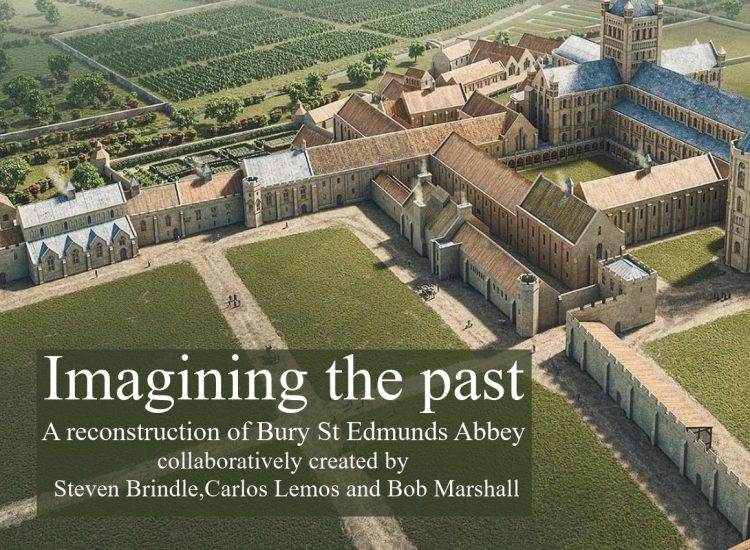
9th July 2024
Imagining the past
Steven Brindle describes how English Heritage created a new reconstruction of the Abbey of St Edmund (from an article in Country Life, June 26, 2024)
Bury St Edmunds is a much-loved historic town, its parish church of St James elevated to the status of a cathedral in 1914. St James’s is a fine building, the body of it designed by the master mason John Wastell in about 1500 but extended with transepts and an eastern arm in 1959—70 by the architect Stephen Dykes Bower. Dykes Bower also left £2 million to fund the cathedral’s completion and, in 2000—05, the superb central tower, which now forms the town’s chief landmark, was finished. Impressive as this church is, behind it are the fragments of a building that once dwarfed it: the Benedictine abbey of St Edmund. If the abbey church had survived, it would be a building of European stature and one of our greatest medieval churches. It has a deep history.

Fig 1
In about AD869 Edmund, the Christian king of the East Angles, was captured and martyred by Danish invaders. Within a generation of his death, Edmund was revered as a saint. By 945, his remains had been moved from their original place of burial to Bury and a wooden church built. Pilgrims started to come and kings of England began to favour the place. In 1032, Cnut built a stone rotunda to house the shrine and turned it into a Benedictine monastery. This, in turn, was given authority over the western third of Suffolk in 1044 by Edward the Confessor, the area becoming known as the Liberty of St Edmund.

Edward’s French doctor, Baldwin, was elected as abbot in 1065 and, in 1080, he began to rebuild the abbey on a monumental scale in the Romanesque style. By about 1120, the crossing and transepts of the church were completed, and the buildings around the cloister were rising. In the mid-12th century, the monastic precinct was extended, taking in a sizeable part of the town and surrounded by walls, most of which still stand (Fig 1). In the 1180s, Abbot Samson presided over the completion of the abbey church, adding octagonal towers to its west front, making it the widest church facade in the kingdom (Fig 4). The church, at more than 500ft long, was also the second longest in England. Indeed, it was probably the fourth largest church in Europe, only St Peter’s in Rome, Cluny in France and Winchester being bigger.
Bury was one of the places where Henry VIII decided on total destruction
Bury was the fifth richest abbey in England and its abbot wore a mitre as a mark of dignity and sat in the House of Lords. He governed a community of about 80 monks, ran vast estates and dispensed hospitality on a huge scale. Kings and queens were entertained here, including John, Henry Ill and Eleanor of Provence, Edward I and Henry VI (who stayed for three months). However, the townspeople and the locals resented the abbey’s control over their lives and relations were often troubled. There were repeated riots and rebellions: the worst one, in 1327, caused huge damage to the buildings. The Great Gate had to be rebuilt afterwards.
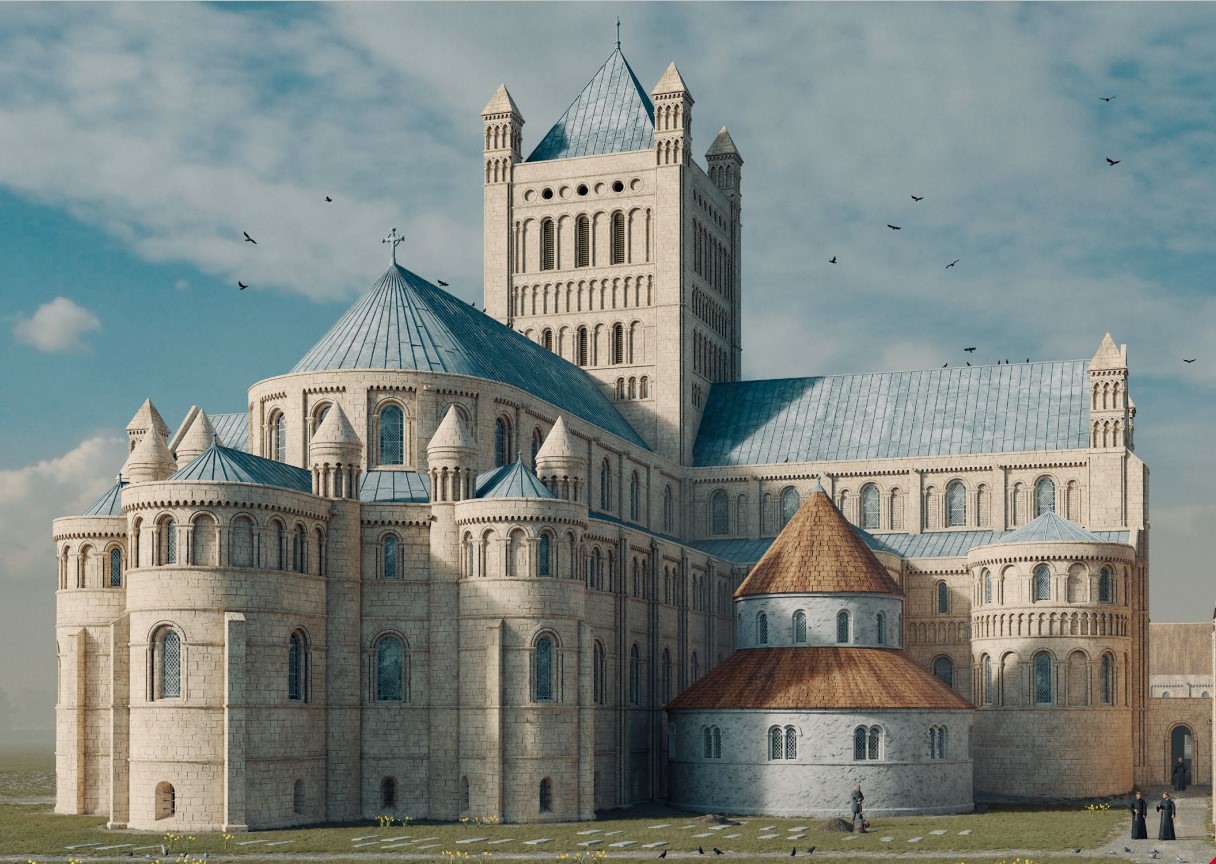
Fig 3: East end of the Romanesque church with its projecting chapels. To the right is King Cnut’s round church built in 1032 and incorporated into the later fabric.
The abbey was famous in other ways, too. It was a centre of learning and home to the historian Jocelin of Brakelond in the late 12th century, then the poet John Lydgate in the early 15th. Its library held more than 2,000 volumes.
In 1430, the great west tower collapsed and reconstruction continued for decades. Before it was complete, however, the nave roof and the central tower were destroyed by fire in 1465. They were rebuilt by the abbey’s master masons, Simon Clerk and John Wastell, who covered the church with stone vaults.
When Henry VIII and Thomas Cromwell suppressed the monasteries in the 1530s, they reprieved a few monastic churches, such as Gloucester, Peterborough, Chester and Bristol, to serve as new diocesan cathedrals. Bury might have been saved in the same way, as it possessed the shrine of a royal saint, as well as the tomb of the King’s sister, Mary, dowager Queen of France and Duchess of Suffolk (d. 1533). However, this was not to be. The King’s commissioners visited in 1538 and stripped its shrine and treasury. The end came in 1539, when the 42 remaining monks were pensioned off and the demolition squads moved in. Bury was one of the places, as were Lewes in East Sussex and Reading in Berkshire, where Henry VIII decided on total destruction.
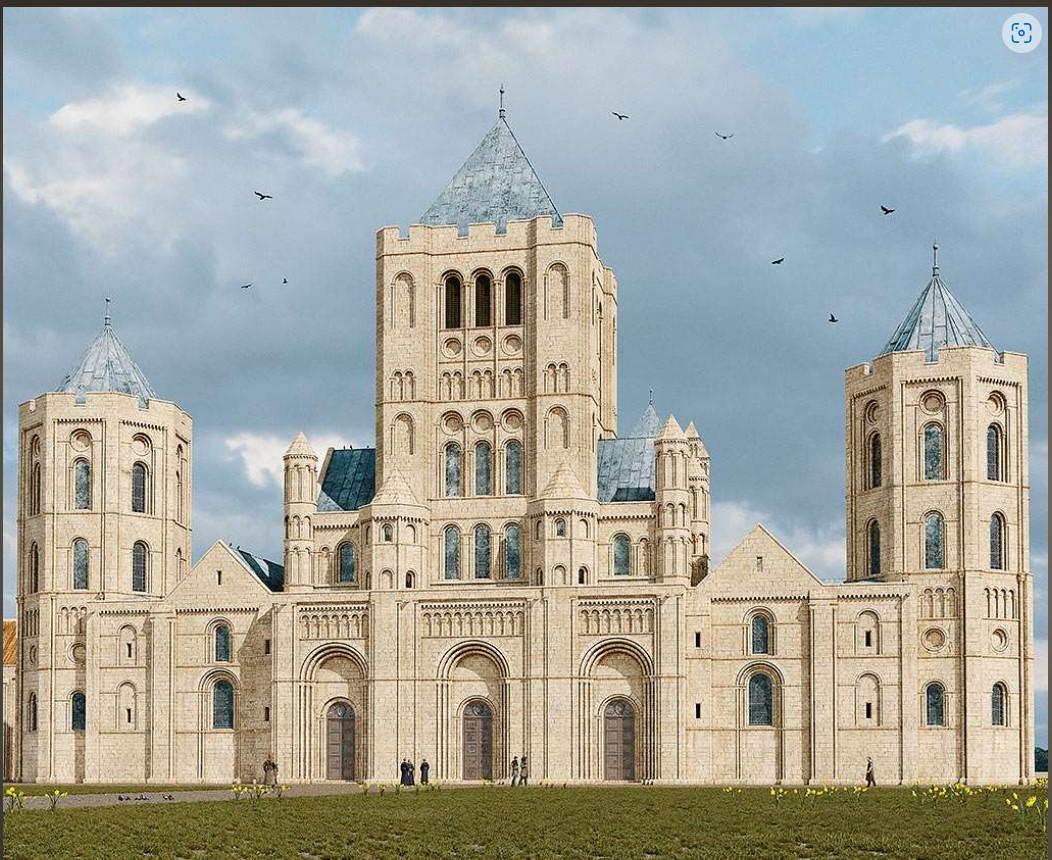
Fig 4: The vast West Front was completed with towers in the 1180s
The church and the main buildings were systematically demolished and the earliest views we have, from the 18th century, show the remains largely as they appear today. The largest surviving elements are the outer precinct walls, with four buildings on the western side: the 14th-century Great Gate, St Edmundsbury Cathedral, the 12th-century Church Gate and the parish church of St Mary, which are worth the trip to Bury in their own right. The mid-12th-century Church Gate, next to the cathedral, was the outer gate to the abbey church and it illustrates the style and scale of the original buildings.
Behind the Church Gate is what remains of the abbey church’s west front. In the 16th century, it was partly demolished and stripped of its facing stonework. The quantity of demolition rubble was so huge that the ground level rose by more than 6ft, so the building is still partly buried. In the 18th century, the shell Of the west front was colonised and it is still occupied by six houses
The abbey ruins were taken into guardianship by the Ministry Of Works in the 1950s. The Ministry’s standard practice, undertaken at many monastic sites, was to clear the overlying rubble and reveal the walls, so the plan could be understood. However, at Bury, this was only partially done; the remains of the eastern arm and transept of the church and a few other areas were revealed in 1957—64. They are set within a well-used public park, laid out with modern planting. The visible fragments of the abbey are so battered— separated from each other and overlaid by modern landscaping—that it is impossible to visualise its layout, scale and appearance (Fig 2).
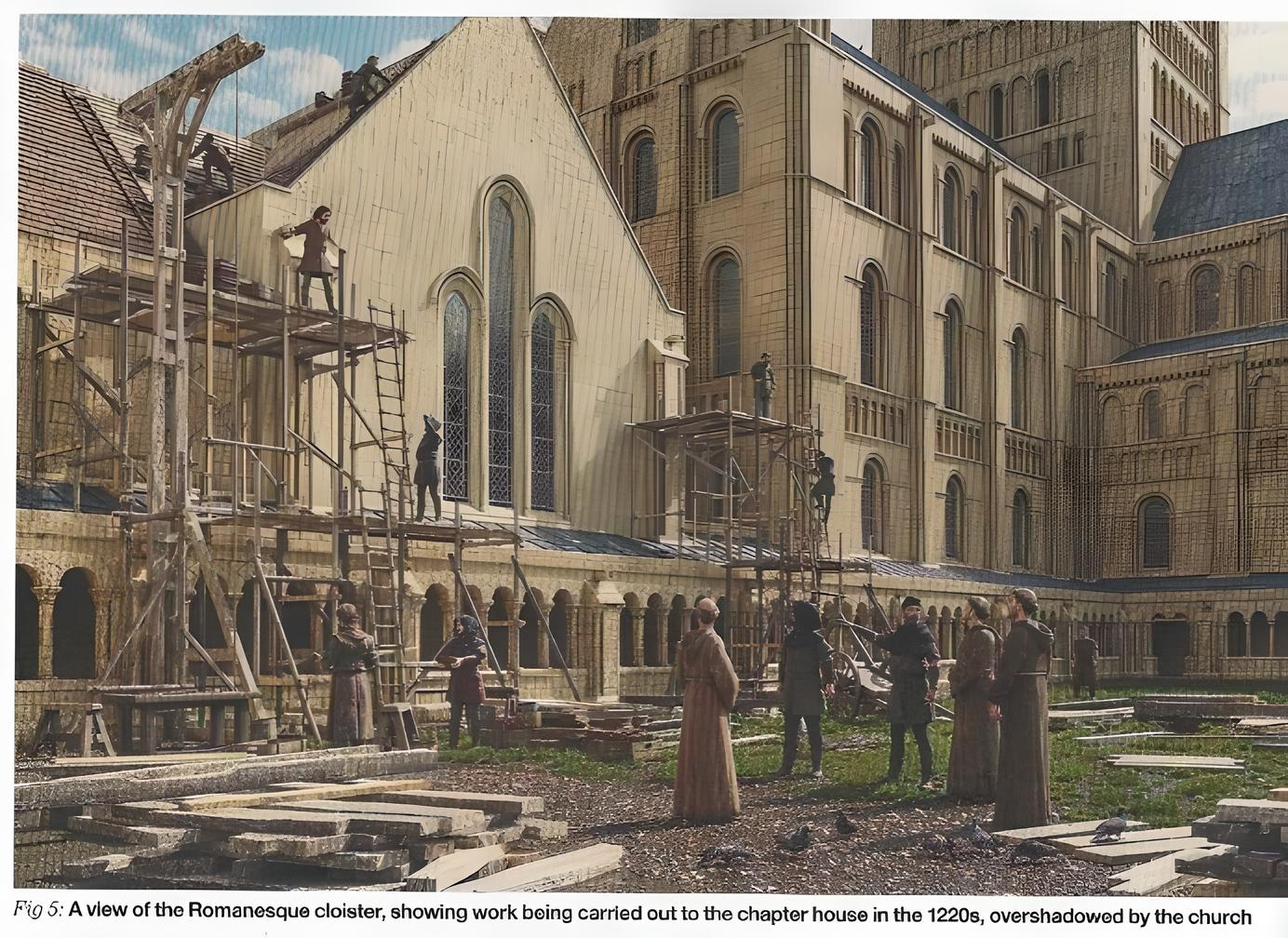
Several antiquaries have tried to understand the abbey’s design but struggled with the incomplete evidence. The most convincing attempt was made by the architect and historian A. B. Whittingham, who produced a detailed plan of the whole complex. One reconstruction drawing was made: a general aerial view, but it got the church’s proportions wrong, with implausibly high towers and spires, and many of the details conflict with visible evidence, so visitors to the abbey found it difficult to understand. In 2021, English Heritage (EH), as guardians of the site, began a project to create new reconstructions to help fill this interpretive void. The core collaborative team included myself, graphics manager Carlos Lemos and the architectural illustrator Bob Marshall. We had several strands of evidence to work from, including the surviving buildings and fabric as recorded in a new metric survey. To these can be added the worked stones recovered during the 1957—64 excavations and the documentary records, including medieval descriptions and later historic views. Finally, there is comparative evidence from contemporary buildings, notably Norwich Cathedral in Norfolk, which was stylistically related to Bury.
The largest surviving part of the abbey church is the west front. Its owners were generous in allowing access inside and the evidence, although fragmentary, enabled us to reconstruct the original plan: a short western transept with a tower rising above it (as at Ely Cathedral), flanked by two-storey chapels, which were, in turn, flanked by the octagonal towers. The houses also embody evidence for the rebuilding of the west front after the 1430 collapse but reconstructing the late-medieval design of the patched up facade will require further work.
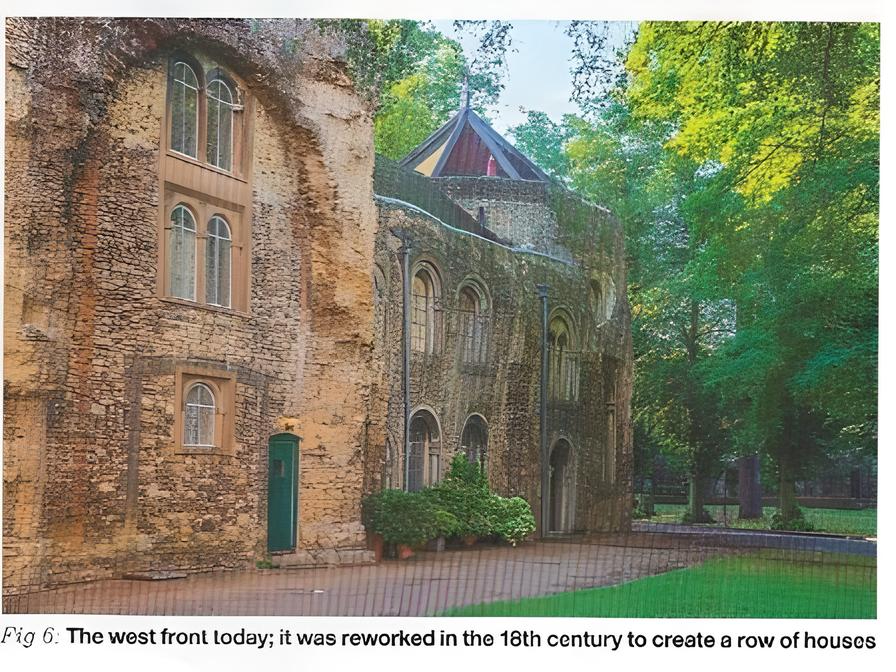
Beyond the west front, most of the nave area is still buried under 6ft of demolition rubble: a few stumps of pillars are visible. The transept, and the crypt that lay below the eastern arm of the church, were cleared in 1957-64, so their plan can be seen. Furthermore, two of the crossing piers still stand. Fragments of the original facing stonework survive low down in these areas, which enabled us to reconstruct the plan of the building in detail. The crossing piers contain vital evidence for the height of the aisle arcades, the triforium arcade and the crossing arches, which provided the outline of the church as a whole, in plan and in section. Salvaged stonework —analysed with the help of Ron Baxter—and comparison with other great Norman churches, notably Norwich, enabled us to work out plausible arch-profiles and details.
Documentary evidence was important in understanding the layout of the abbey church. Before 1539, one would have seen a long arcaded nave, similar to that of Norwich and similarly crowned with 15th-century stone vaulting (Fig 7). A carved stone screen, called a Pulpitum, blocked the nave: beyond this was the monks’ choir, the liturgical heart of the building. To either side were the transepts, with chapels on their eastern flanks. Above rose a central bell tower. In the reconstruction, this is shown as being twice the height of the nave parapets, a notion that was based on three great churches, Norwich, Tewkesbury in Gloucestershire and St Albans in Hertfordshire, which retain central Norman bell towers and have similar proportions. The details of the tower were based on the surviving Church Gate and on Norwich Cathedral.
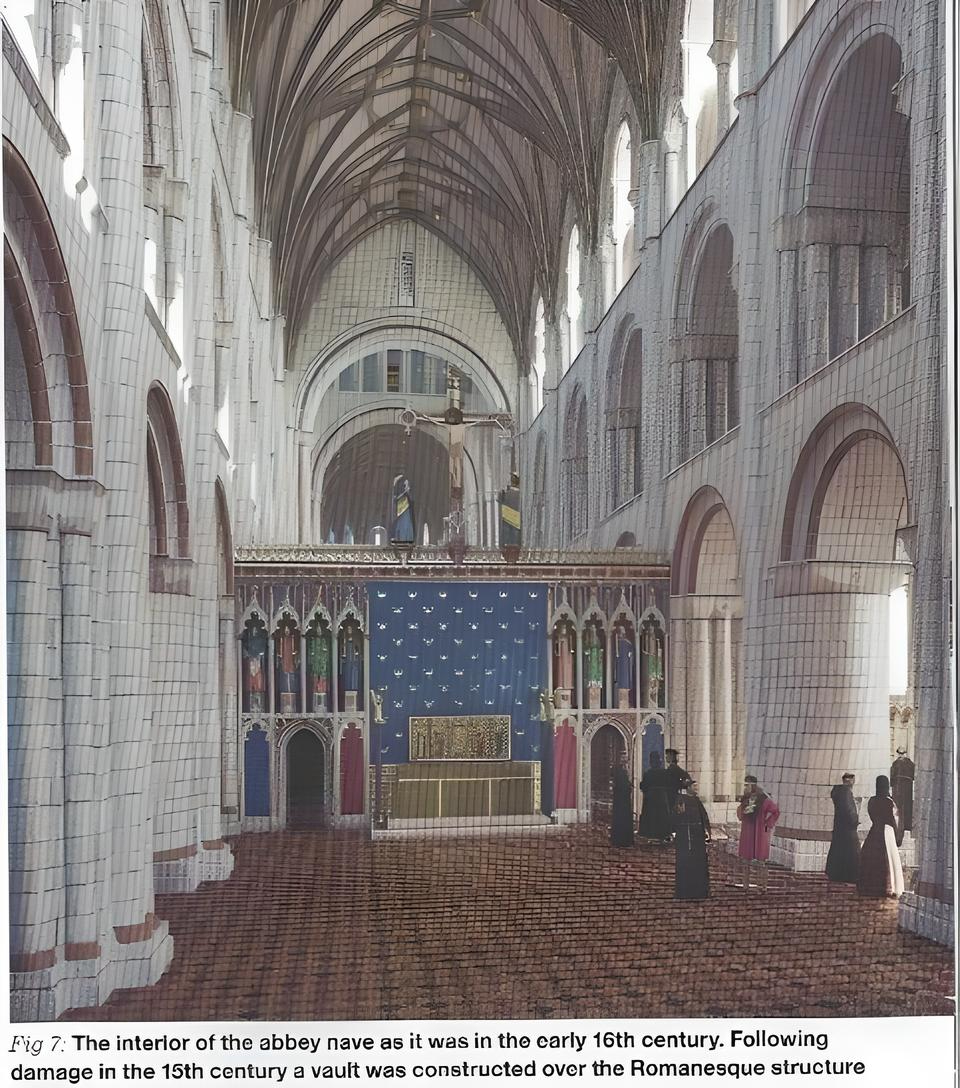
To the east was the sanctuary, raised up on the crypt. As in most great Norman churches, it was built with a D-shaped eastern end and projecting chapels (Fig 3). At many English cathedrals, the eastern arm was later rebuilt with a square east end, but at Bury, this arrangement survived. The sanctuary housed the high altar, with the shrine of St Edmund beyond it. and its appearance is known from 15th-century manuscripts. In 1538, the commissioners found a ‘rich shrine very cumbrous to deface’: they took more than £3,000-worth of gold and silver, with many other precious objects. We do not know what happened to Edmunds remains, although it is possible that the monks reburied them in secret.
The site of the Chapter House, to the north, was excavated by the antiquary M. R. James in 1903. The abbots’ graves, which he discovered, can still be seen and give a sense of the size of the space. The other remains, however, are scattered and fragmentary. There are evocative areas, such as the remains of the great chamber of the Abbot’s Palace, and the Abbot’s Bridge at the north-east corner of the site, which carries the precinct wall over the River Lark. A view of the cloister (Fig 5) and a general aerial view of the abbey have been produced, to help visitors understand the site, although the evidence for this is more patchy than for the abbey church.
EH unveiled its new interpretation panels in the summer of 2022, but much more could still be done. The Abbey of St Edmund Heritage Partnership, an alliance of stakeholders that includes the cathedral, community groups and the local authorities, as well as EH, is developing plans to improve the understanding and interpretation of this nationally important site further. Many questions remain, but a modicum of imagination can help us to recover something of the lost glory of this extraordinary building.
Similar articles
3rd February 2025
New Panels for Abbey of St Edmund 1000 Murals
The team behind the Abbey 1000 celebrations which took place in 2022,…
3rd January 2025
Conservation work on the Abbey begins
23rd November 2024
Architects and Consultant Team announced
St Edmundsbury Cathedral, together with its partners West Suffolk Council and English…
View all news
